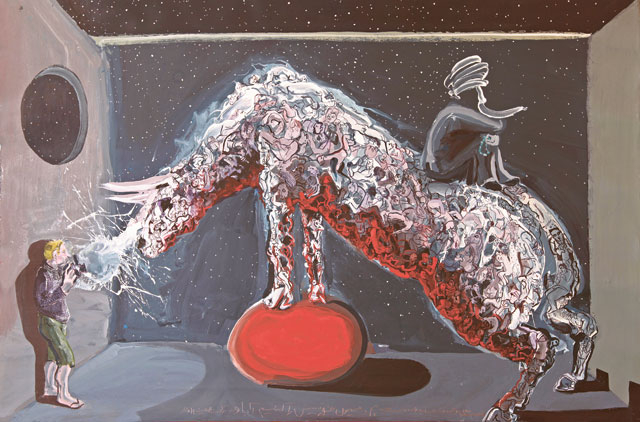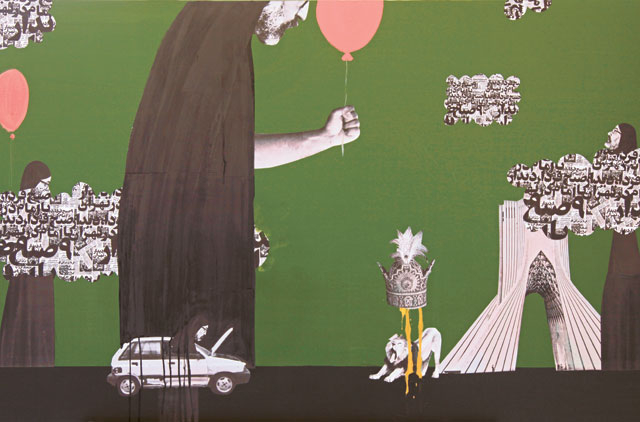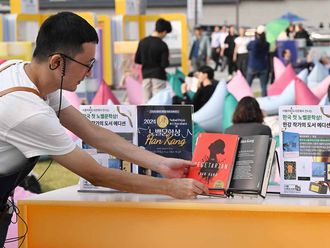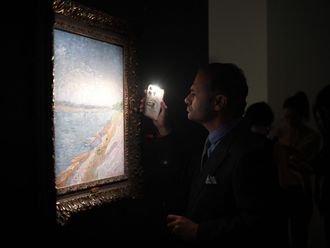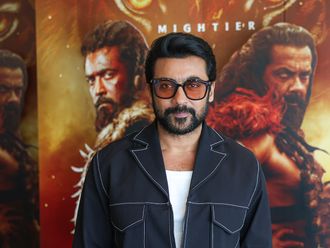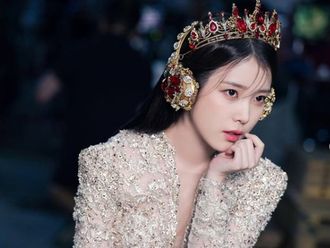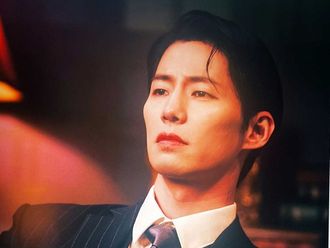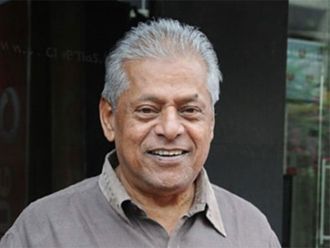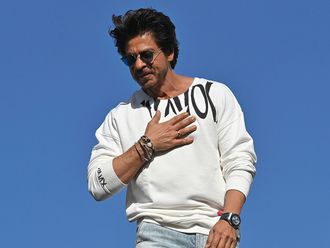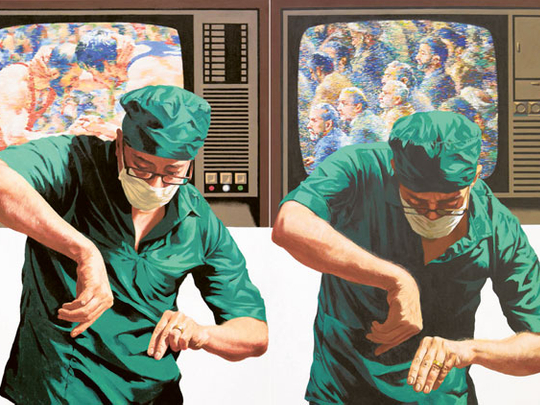
It is impossible to look at Iranian art without seeing the spectres of coups and conspiracies, revolution and repression — tumultuous times that gave birth to a diaspora of talent that has spread far from the artists' studios in Tehran to New York, London, Berlin and Dubai, anywhere they can practise their art in freedom.
But as Ali Bakhtiari, curator of Magical Nights 2012, a three-night event in Dubai from March 21 organised by the UK-based charity Magic of Persia, insists: "There is a kind of invisible spirit that unites the artists wherever they are based. The concepts or the medium may have changed, but you look at their work, whether based in their own country or in the outside world, and see something that binds them together."
Amid a flurry of cocktail parties and the fluttering of the cognoscenti, it is hoped that many dollars will be spent in an auction of works by established artists, but more interestingly perhaps, a silent auction will showcase 25 emerging artists, such as Farrokh Mhadavi, who, says Bakhtiari, is "doing great artworks which I found hidden away in his Tehran studio", Babak Golkar, at present on a residency at The Delfina Foundation, London, Afsoon, based in London after a time in San Francisco, and painter-sculptor Shaqayeq Arabi, who now has a studio in Dubai.
The money raised by the charity will promote modern, contemporary and classical Iranian art, music and media in partnership with world-class institutions such as the Delfina, and will also offer MA scholarships at the London Film School. Magic of Persia also organises a Contemporary Art Prize (MOPCAP), which was won last year by Sweden-based Shirin Sabahi, 29. She has been awarded a solo exhibition at the Saatchi Gallery during this year's Frieze Week for her film Present Perfect Tense, which is based on the archive of a middle-class Swedish family, using almost 60 reels of 8mm film shot between 1935 and 1988.
A poetic balance
The runner-up, Shahrzad Changalvaee, 29, however, is still living in Tehran and her work explores typography, and photography in a way that is unmistakably Iranian, Bakhtiari suggests, with nods to the traditions of a Persian past while addressing contemporary concerns. Her award-winning series of photographs, Body Composition Remaining Within Limited Domain, shows characters in wastelands and streets holding up one of three words in Persian — I, Body and Motherland.
"These three words have letters in common, which makes the idea poetic," she says. "Many young people are leaving Iran these years, so moving your body, choosing another land and finding yourself another ‘I' — it's a challenge we Iranians, mostly the middle class, face.
"There are obstacles for many artists. There are strong limitations in showing art in publications. Many artists can't show their works in Iran, some exhibitions are closed by the government and some artists are called for explanations or arrested."
While Changalvaee perseveres in her homeland, the event represents a roll call of leading contemporary artists who have left Iran to avoid those "strong limitations". Along with Shirin Neshat and Kamrooz Aram, both based in the United States, there is Farhad Ahrarnia, showing at the Rose Issa Gallery in west London at present, and the two iconoclastic brothers Ramin and Rokni Haerizadeh, whose controversial work has compelled them to seek "exile" in Dubai.
These are the headline makers whose works will continue to propel Iranian art into international consciousness. However, maybe greater proof of its growing importance is the interest shown by London's British Museum, which has been quietly collecting Middle Eastern contemporary art for the past 20 or more years.
Museum curator Venetia Porter says: "We felt we needed to come up to date with our collection of Middle Eastern art. We began building up the collection with only a little money and not really knowing what we wanted, because it was actually quite difficult to get a picture of the art scene there.
"In 2006 we held a small exhibition called Word into Art, which was about the use of script by 80 different artists as both a method of communication and an art form in the ancient and Islamic cultures. The show caused ripples in Dubai and it coincided with a lot of marketing developments and the first auctions there, so many things were happening together."
The museum collection comprises 200 works, mainly on paper, including calligraphic scrolls by Golnaz Fathi, a photography series by Sadegh Tirafkan and two works by the Haerizadeh brothers.
Ramin's is a trademark series of photographs called Bab Hejab, in which he plays all the characters — wearing a beard, something associated with clerics in the Middle East — using situations in which he casts himself as decidedly irreverent.
Rokni's work, from his Fictionville series, is an uncomfortable subversion of photographic images which satirises the leaders of the country he felt compelled to leave.
The most recent acquisition is a lino block by Charles Hussain Zenderoudi, the pre-eminent modernist of the Fifties and the Sixties who also left his country, moving to Paris in 1960.
"It is a re-interpretation in astounding detail of the death of Hussain Ibn Ali in the Battle of Karbala," Porter says. "It is based on the kind of posters that are carried around in Iran today when Shiites mourn his death.
"These modernists were a fascinating group who encouraged people interested in their own historical and cultural traditions, and wanted to create works around those themes. As a history museum we have to connect with such movements and somehow offer a perspective on the historical traditions that have influenced the emerging artistic trends today.
"We provide the context of ancient and modern global culture back to the 19th century and to Islamic art. It's a sort of timeline. In our collection we see how the artists speak of their time and how they represent the social and historical realities of the modern Middle East."
It is a timeline that highlights the change and turmoil of Iran since the Fifties.
Shirley Elghanian, the driving force behind Magic of Persia, said to me on the eve of the last MOPCAP: "What we are seeing is that the repression is having the opposite effect because it has served as an impetus for protest. Take for instance the Haerizadeh brothers, whose work appeared in the Saatchi exhibition in 2008. Because there is a lot of nudity and implications of homosexuality in their work, they cannot go back to Iran.
"It makes it all the more important for Iran-ians to connect with the West, to reach out. They want to be Westernised and feel accepted internationally rather than be in their little cocoon. Above all, they want to be recognised as Iranians."
Certainly, most of the works have a distinctive identity that, almost without exception, reveal a sense of longing for a country that many no longer live in, and a recognition that exile — either voluntary or forced — might be permanent. The spirit that Ali Bakhtiari refers to is clearly visible in the use of calligraphy and the reworking of traditional art forms.
"Calligraphy plays a massive role," Porter says. "But often it is more than that — not calligraphy but writing, telling the story, whether by using poetry or political slogans. That's very important in Middle Eastern culture, and easy to incorporate into whatever work is being done.
"Take Shirin Neshat; her work is very nostalgic. She left Iran after the revolution of 1979 and is better known in the West than in her homeland. She was drawing attention to what was going on when she made Women Without Men, which is a wonderful film set at the time of the CIA and the British-backed coup against the Iranian government in 1953."
New York-based Neshat has been inspired by the literature of Persian masters, such as the mystic Rumi, the poets Hafez, Khayyam and Ferdousi, and like many of her contemporaries uses poetry "to cope with the perpetual political oppression ... by one dictatorship or another".
Her most recent exhibition has just closed at New York's Gladstone Gallery. Called Book of Kings, it comprises 60 black-and-white portraits fantastically decorated in Sufi-inspired calligraphy, with selections of modern poetry, stories and memoirs of protesters and prisoners.
‘History tends to repeat itself'
It has parallels with the ancient epic, the Shahnameh, written by Ferdousi 1,000 years ago. "Poetry and other forms of texts have been applied either in the form of calligraphy or as songs in my video installations," Neshat says. "Meanwhile, every work has also either directly or indirectly framed some sort of political issue, such as the Islamic revolution, the political oppression, martyrdom or the 1953 coup.
"Ultimately, I found that history tends to repeat itself. So in 2010, as I started to plan the new series of photographs inspired by the Iranian and Arab uprisings, a few themes became central to my subject: courage, patriotism, love, devotion, but also betrayal, cruelty, suffering and ultimately death."
Neshat has an optimistic take on the effect the Arab Spring might have on the region's artistic climate.
"We had already witnessed an interesting cultural growth in the Middle Eastern artistic climate, where it clearly began to challenge the West by building strong markets and important art institutions," she says. "But I predict that we will see a new shift that will be less driven by the market and more by the political transformations that have been taking place in the region.
"As I'm spending a lot of time in Egypt, I see how a wave of expatriates, particularly artists, writers and intellectuals, have been returning to live in Cairo to join the popular uprising. From what I can see, they feel invigorated not only by being present in their country as history is made, but also to take a part in this movement."
Bakhtiari agrees. "Like so many expatriates," he says, "she has been inspired by heritage and translated it despite her years away. You can see the deep attachment to the country.
"It is as if they and many others have digested their history and made it international and global. There is nothing pretentious about them — so many artists try to be exotic — they instead have become very radical. This really began in the mid-Eighties, when a new generation was coming through. But it is hard for those working in Iran today because there is little contemporary art in Tehran.
"The museum is neglected and after all the years of censorship, there are few records to give a sense of history and context. Also, it's not easy with the present economic crisis — we are hard hit by sanctions — and the first thing people eliminate from their buying is art, so it is difficult to survive."
On the other hand, Porter says: "Yes, things are very difficult in Iran, but in terms of art the scene is really, really vibrant. One evening a week a quarter is open to the public and it is full of galleries, which are terrific.
"There is censorship, but what's clever is that all these artists find ways of doing their work which is very subtle and interesting, so that the messages are quite subliminal, but not in-your-face or antagonistic. And not all works have to be political, do they?"
The fourth edition of Magical Nights will be held from March 21 to March 23 in Dubai.
Richard Holledge is a writer based in London.


